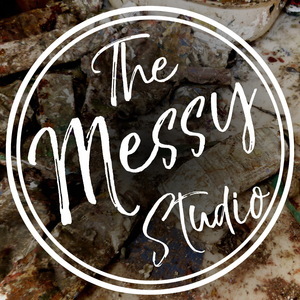When Is It Finished?
Episode 162 · January 23rd, 2021 · 35 mins 17 secs
About this Episode
Every time we make a piece of art, we reach the point of deciding if it’s finished --yet as common as this moment is in studio life, it is often one of doubt and second-guessing. What are some meaningful criteria for when something is done? Are there questions to ask ourselves in declaring something finished? Do we have to finish everything, or is it OK to abandon certain pieces? Today we will look at this ordinary but complex process of deciding a work of art is done.
Many times, artists look to others for an opinion about whether a work is done, abandoning their own decision process for someone else’s view. It’s also very common for someone—a well-meaning instructor, friend, artist, or a family member—to offer unsolicited advice about something being done. “Don’t touch it, it’s perfect” may seem like a helpful comment, but it can hinder the artist’s own path and vision. In a classroom situation, an instructor’s role may be to push a student who wants to stop too soon, but within the context of the student’s own goals. For all of us, asking for or offering constructive feedback is helpful, but we need to take responsibility for setting our own criteria for finished work.
That involves intuition of what feels right, plus an objective understanding of weak spots and the need for more edits and changes. Coming up with good questions and criteria to decide if something is done is important. And it’s also important to be honest about feeling impatient or being willing to settle for less than you are capable of creating in the desire to be finished.
Often, we need to set a work aside to gain some distance and insight into where a piece is heading. And sometimes, we can decide that we’ve learned what we can and move on. Even with media that can be reworked many times, like an acrylic or oil painting, abandonment can sometimes suit our best interests. It may not be until we start something new that we realize how much we’ve learned in the previous struggle.
In the end, taking full responsibility for deciding something is done and gaining some clarity about your own criteria is the path to excellence in your work.
Thanks to everyone who has been sharing the show and to Anne Jackson for donating via PayPal. Check out her website at https://www.annejacksonfineart.com/. We mentioned her in Episode 158, Abstracting With Emotion. If you would like to donate to the Messy Studio Podcast donate here.
When you buy art supplies at Blick remember to use our affiliate link to support the podcast! Bookmark this link and then you don't even have to think about it again. This is one of the best ways to support the show. It takes a few seconds and costs you nothing!
Right now Gamblin products are 40% off, so this is a great time to buy Cold Wax or Gamblin oil paints!
www.messystudiopodcast.com/blick
Cold Wax Academy (formerly Squeegee Press) would like everyone who enjoys using their special cold wax tools to know that all sizes of SP Create squeegees are back in stock! Rebecca and her partner Jerry McLaughlin are also launching their online live learning sessions as part of the new membership program, and all sessions will be recorded for future viewing by members. For more information, and to become a member of Cold Wax Academy please visit their website at http://www.coldwaxacademy.com and click on the Membership button.
Have an art related product, service, or event you would like to advertise on the Messy Studio Podcast?
Email Ross at [email protected] for current mid-roll advertising rates.
For more from The Messy Studio:
www.messystudiopodcast.com
www.facebook.com/messystudiopodcast
For more from Rebecca Crowell:
www.rebeccacrowell.com
www.coldwaxacademy.com
The Messy Studio Podcast is a CORE Publication MGMT production.
